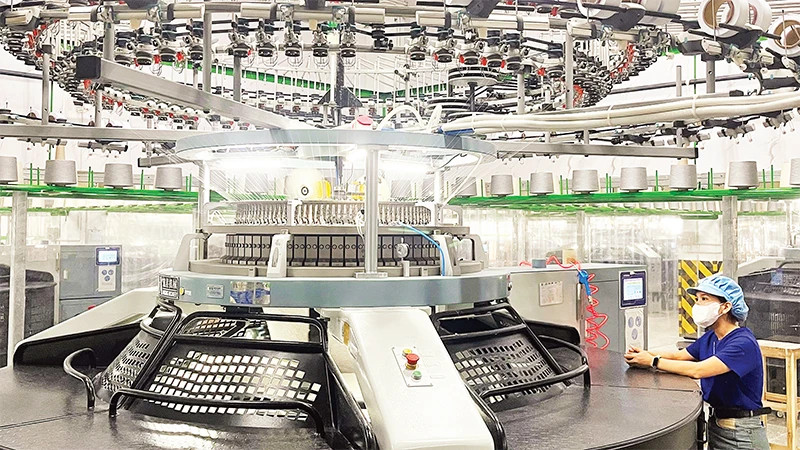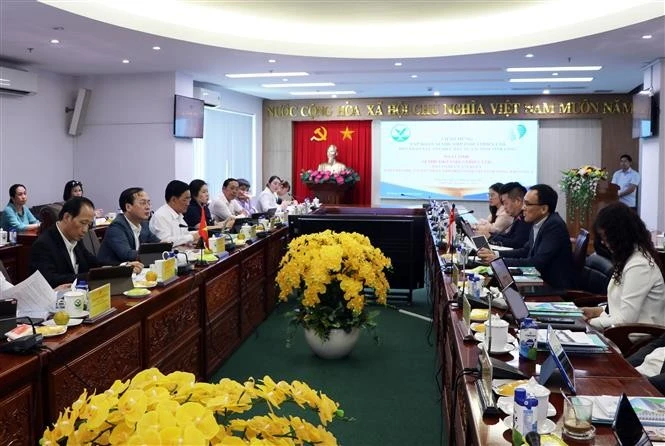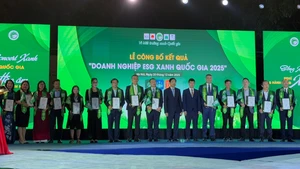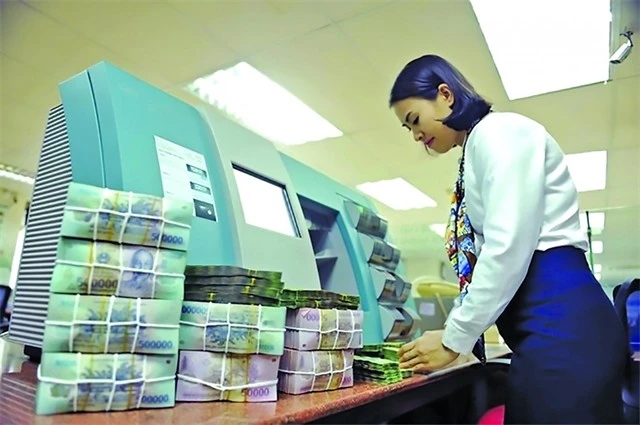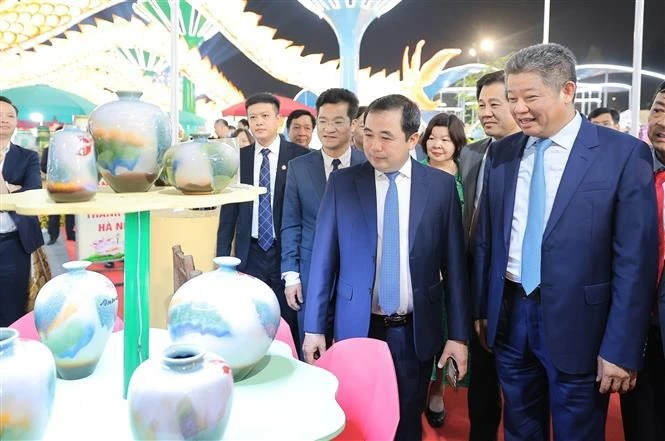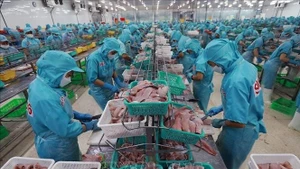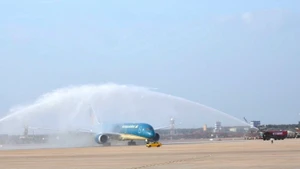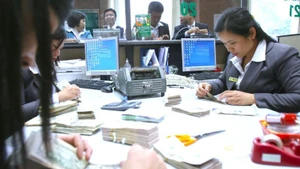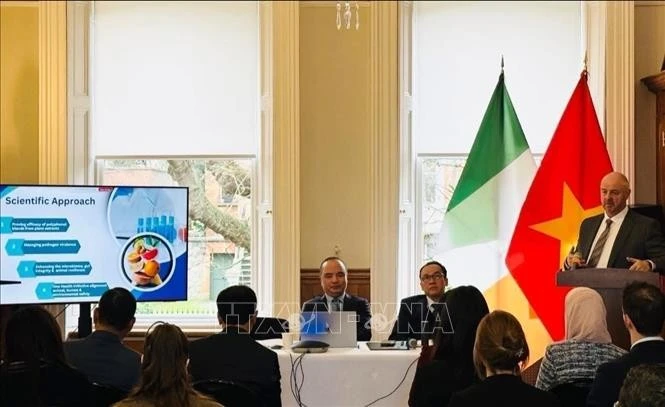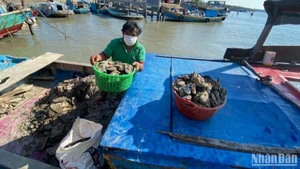“Activating” many large projects
Regarded as a locality with many advantages in attracting investment with a convenient traffic infrastructure system connecting with neighbouring areas and an open investment environment, in recent years Ha Nam Province has been in the group of provinces and cities attracting a lot of foreign investment capital.
Many years ago, due to its geographical location and inconvenient transportation compared to neighbouring localities, Nam Dinh Province was considered a less attractive locality in terms of investment environment. However, this situation has completely changed.
Statistics for the first 10 months of 2024 show that Nam Dinh Province has granted new investment registration certificates and adjusted capital increases for 61 projects (including 32 domestic investment projects and 29 FDI projects) with total registered capital of more than 7.2 trillion VND and nearly USD 229 million.
 |
| Construction commences on the Pesico Vietnam food factory in Ha Nam Province. (Photo: DAO PHUONG) |
The main source of investment capital comes from large-scale corporations and enterprises applying modern, environmentally friendly production technology, such as Quanta Computer Inc. of Taiwan (China), Toray Group (Japan), and Sembcorp Group (Singapore).
As for Thai Binh, with its open incentive mechanisms, it has recently been “ranked” as a locality that attracts many foreign investment sources.
Nguyen Khac Than, Chairman of the People’s Committee of Thai Binh Province, said that the province has proactively reduced the time limit for handling administrative procedures by 40%, creating maximum favourable conditions for people and businesses. In 2023, the province’s FDI attraction reached more than 2.9 billion USD, nearly 4.4 times higher than in 2022, helping the province enter the top 5 provinces and cities attracting the largest FDI in the country. In 2024, despite many difficulties, the province strives to attract about 1 billion USD in FDI by the end of December this year.
In particular, Hung Ha District (Thai Binh Province) is a locality with many large-scale projects, thus creating spillover effects in the socio-economic development of the whole region.
 |
| Workers at the TOP TEXTILES Textile and Dyeing Factory in Rang Dong Textile Industrial Park, Nghia Hung District, Nam Dinh Province. (Photo: XUAN TRUONG) |
According to Tran Huu Nam, Secretary of Hung Ha District Party Committee, in October 2024 alone, the district “activated” a series of projects with total investment capital of about 9 trillion VND, including: starting construction of Thai Binh Vegetable Oil Factory, groundbreaking at Duyen Hai Hot Mineral Resort, renovating the Memorial Site of scholar Le Quy Don, inaugurating and operating Thai Hung Domestic Waste Treatment Area, etc.
Ha Nam Province’s investment promotion activities also have many innovations. In 2024, the province has developed plans and organised many delegations to promote investment in developed countries around the world.
According to statistics, the province currently has 10 industrial parks approved for investment, with a total area of nearly 3,000 hectares, of which 8 industrial parks are in operation. In the first 10 months of 2024, the province attracted 71 new projects and adjusted the investment capital of 52 projects with a total newly registered and adjusted capital of 497.5 million USD (up 26%) and 11.26 trillion VND (up 34% over the same period last year).
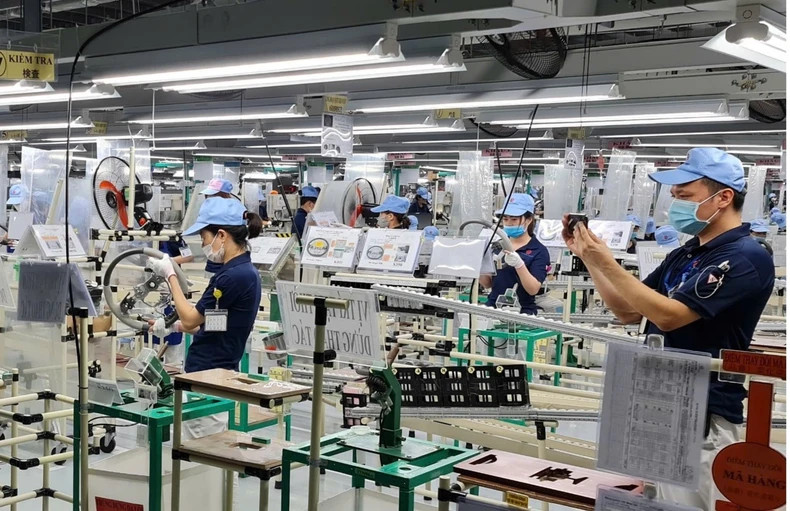 |
| Toyota Gosei Company (Japan) has invested in a factory producing automobile steering wheels in Tien Hai Industrial Park (Thai Binh Province). (Photo: MAI TU) |
To date, Ha Nam has 1,242 valid investment projects, including 405 FDI projects and 837 domestic projects with total registered capital of nearly 6.5 trillion USD and more than 180.69 trillion VND.
Industrial parks alone have 611 projects, including 360 FDI projects and 251 domestic projects with total registered capital of 6.249 trillion USD and more than 50.5 trillion VND. In addition to industrial parks, there are 631 projects, including 45 FDI projects and 586 domestic projects, with total registered capital of nearly 306 million USD and more than 130.22 trillion VND.
Despite many changes, in reality, compared to other economic sub-regions in the country, the actual investment attraction of the three southern provinces of the Red River Delta remains modest, and is not commensurate with their potential and advantages. Therefore, in the coming time, the entire political system of the three localities has shown a strong determination to innovate investment attraction, creating momentum for the socio-economic development of the provinces.
 |
| A working delegation visits the Dell laptop production and assembly line at the Wistron Infocom Factory in Dong Van Industrial Park, Ha Nam Province. (Photo: DAO PHUONG) |
Synchronising investment attraction solutions
Pham Gia Tuc, member of the Party Central Committee, Secretary of Nam Dinh Provincial Party Committee, said the province has changed its investment attraction strategy; not waiting for investors to come, but proactively promoting and inviting investors; taking advantage of every opportunity, through economic, political, social events, diplomatic agencies, foreign enterprises that are investing effectively.
The leaders of Nam Dinh Province have made great efforts to promote and introduce the province's potential strengths, development orientation, and incentives in attracting investment, while at the same time requiring units to continue to promote administrative reform, improve competitiveness, promote and attract investment, as well as implement the Master Plan for administrative reform of Nam Dinh Province for the 2021-2030 period. Every year, the province reviews and comprehensively evaluates the Administrative Reform Index (Par Index) and the Satisfaction Index of Administrative Services (SIPAS) as a basis for developing plans and solutions for the following year.
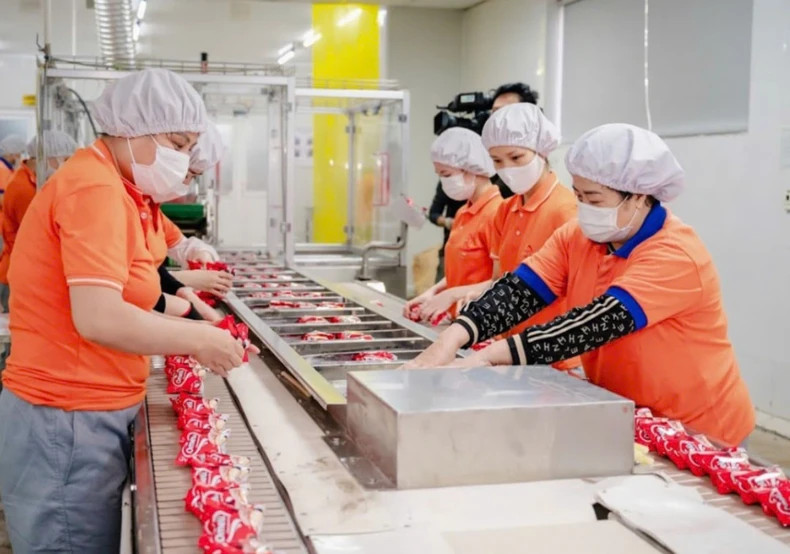 |
| Modern confectionery production line of Bao Hung International Joint Stock Company (Vu Thu District, Thai Binh Province). (Photo: MAI TU) |
The province also directs departments, branches, and local authorities to proactively review and remove bottlenecks and obstacles in attracting investment. Provincial leaders directly direct and urge the removal of obstacles as soon as possible within the province’s authority.
There have been “records” in the speed of granting Investment Registration Certificates in Nam Dinh, such as the project to manufacture computers and computer peripherals for Quanta Computer Inc. of Taiwan (China) being granted an Investment Registration Certificate just 1.5 days after the investor submitted a written request, with the Enterprise Registration Certificate granted six days later, 20 days after signing the project development agreement.
Deputy General Director of Quanta Computer Inc. Vu Quoc Phong said: Thanks to the very active support from authorities at all levels and functional sectors, just 16 months after being granted the Project Investment Registration Certificate, the Group has officially exported two batches of laptop samples from the factory in My Thuan Industrial Park (Nam Dinh City) to supply to customers.
In addition to innovating investment promotion activities, the provinces in the southern Red River Delta also focus on investing in creating breakthroughs in transport infrastructure, opening new development spaces, and attracting businesses. During the 2020-2025 term, Nam Dinh Province has mobilised investment resources to build a series of key traffic routes, connecting with key economic zones of the region and the country.
For example, the coastal road section through Nam Dinh; the development axis connecting the province's marine economic zone with the Cau Gie-Ninh Binh Expressway (Provincial Road 490); New road route Nam Dinh-Lac Quan-Coastal road (Provincial Road 484), etc. At present, the province has basically completed investment and established the transport infrastructure system of 3 out of 5 economic corridors according to the Nam Dinh Provincial Planning for the 2021-2030 period, with a vision to 2050.
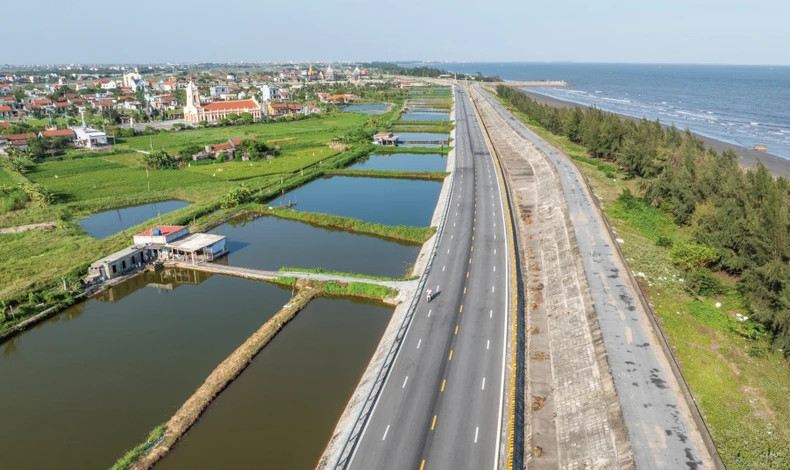 |
| The coastal road section in Hai Hau District, Nam Dinh Province, has just been invested in, built and put into use, facilitating the connection of goods trade between coastal provinces. (Photo: VIET DU) |
Industrial infrastructure has been focused on investment by the provinces, ready to supply to businesses. Ha Nam Province has reviewed and proposed to adjust the planning of industrial parks and clusters in the direction of maximising the advantages of transport infrastructure and logistics services; prioritising synchronous investment resources in socio-economic infrastructure, especially transport infrastructure to ensure connectivity and smoothness; and ensuring infrastructure systems for power supply, telecommunications and water supply and drainage to the foot of the factory fence fully and stably meet the production needs of enterprises.
Nam Dinh Province is also implementing a series of industrial parks and clusters such as: Rang Dong Textile Industrial Park (Nghia Hung District) with a scale of more than 500 hectares; My Thuan Industrial Park (Nam Dinh City) 159 hectares, etc. Currently, the province has 6 industrial parks and 24 industrial clusters; it is expected that by 2030, 16 industrial parks will be formed with a total area of about 2,546 hectares and 70 industrial clusters (more than 2,600 hectares).
Comrade Nguyen Khac Than, Chairman of the People’s Committee of Thai Binh Province, stated: Each cadre and civil servant of the departments, branches and units of the province is required to flexibly and creatively apply the provisions of the law at the highest level in the process of solving work; Review administrative procedures, and on that basis make appropriate adjustments to the actual situation.
Thai Binh Province will publicise and make transparent the time, procedures, order and results of handling administrative procedures for investors; enhance the responsibility of departments, branches, localities, especially the presiding agencies in the process of handling investment procedures.
